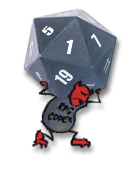While I like that system a lot it's not quite the same as RT simulation. The roguelike model is based around discrete tiles, and discrete moves that happen instantaneously when it's your turn, just the cooldown for when your next turn will come up is determined by how long an action you just did. It's still turn-based but with a more freeform turn order.You could always use the roguelike approach to turns - all movements/actions for all entities tracked by the game in each turn are taken substantially simultaneously (Still a determination of initiative, but it essentially determines whose attacks are calculated first). Which is actually my favorite system, but I just don't think I've seen it too many proper RPGs.
It simply can't do things like physics simulation for game mechanics that RT(wP) can.
Very true. Although, I probably should clarify; the point I was trying to make is that if you want actions by both sides to be taken simultaneously, I think it can be done with a turn-based system, assuming we have the same view of what simultaneously means; I'm assuming that "simultaneously" isn't being used to mean literally at the exact same moment and is, instead, used to mean the actions of all combatants are taking place in parallel rather than in a pure sequence. After all, very few things happen literally simultaneously, its just the difference in time is small enough that we don't notice.
Basically a turn is an artificial representation of time, with the amount of in-game time it represents usually being chosen to represent enough to do quite a bit - move, swing a sword, cast a spell. So you could look at RTwP as a TB game where every second is a turn and, if no actions are chosen, the computer will choose them for you (or a TB game as a RTwP game where you have to give permission for time to pass). So if you break turns into small enough units of time that they encompass the smallest significant component of each combatant's action (so steps, but not heartbeats), you can have a turn based system which can, for the purposes of gameplay, approximate simultaneity, or at least something that approaches it very closely.
As an example, take a game like Fallout and replace each individual action point with a turn (yes, I know this would break many aspects of the game, just humor me). You take a step, everyone gets to take a step. You use a three action point move, everyone can take two more steps before you complete it, meaning that although things are happening in sequence, the series of actions which add up to a significant maneuver will be happening in parallel.
If you tweak things by removing the need for initiative (so two actions completed in any given turn both register in the same turn, even of one action would kill the character taking the other action), then you can have actual simultaneity with a TB system.
Of course I don't have a problem with RTwP, I prefer TB, but tastes vary and, as many others have pointed out, both require different skills and mindsets. I just think that simultaneity is possible in a TB system, its just a question of what subset of the combat you want to have happening in parallel and how much action you want to represent in each turn.
EDIT: I should also add that I'm not entirely clear on what physics simulations can be done in RT but not TB. I'm assuming you were talking about RT's advantages in simulation, rather than purely simultaneity. But either way, I'd be interested in an elaboration on what these are.
























![Glory to Codexia! [2012] Codex 2012](/forums/smiles/campaign_tags/campaign_slushfund2012.png)






